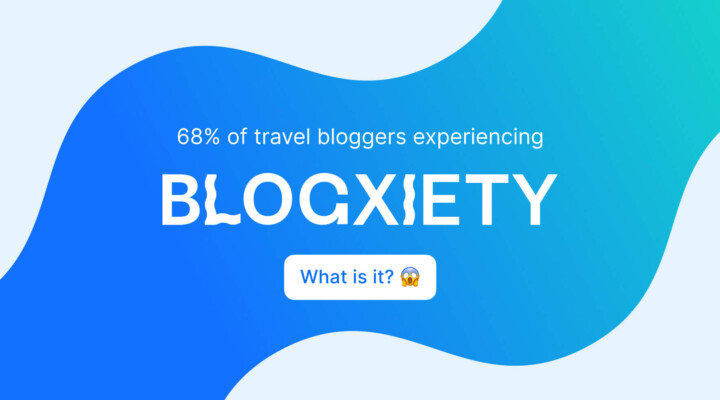Best Affiliate Marketing Website Examples
The Internet is full of affiliate marketing websites, but not all of them can become an example to follow. We have gathered some of the best blogs on the web that feature top-notch content, have efficient marketing and monetization strategies in place, are properly optimized for search engines, and stand out from the competition in other ways.
Map Happy
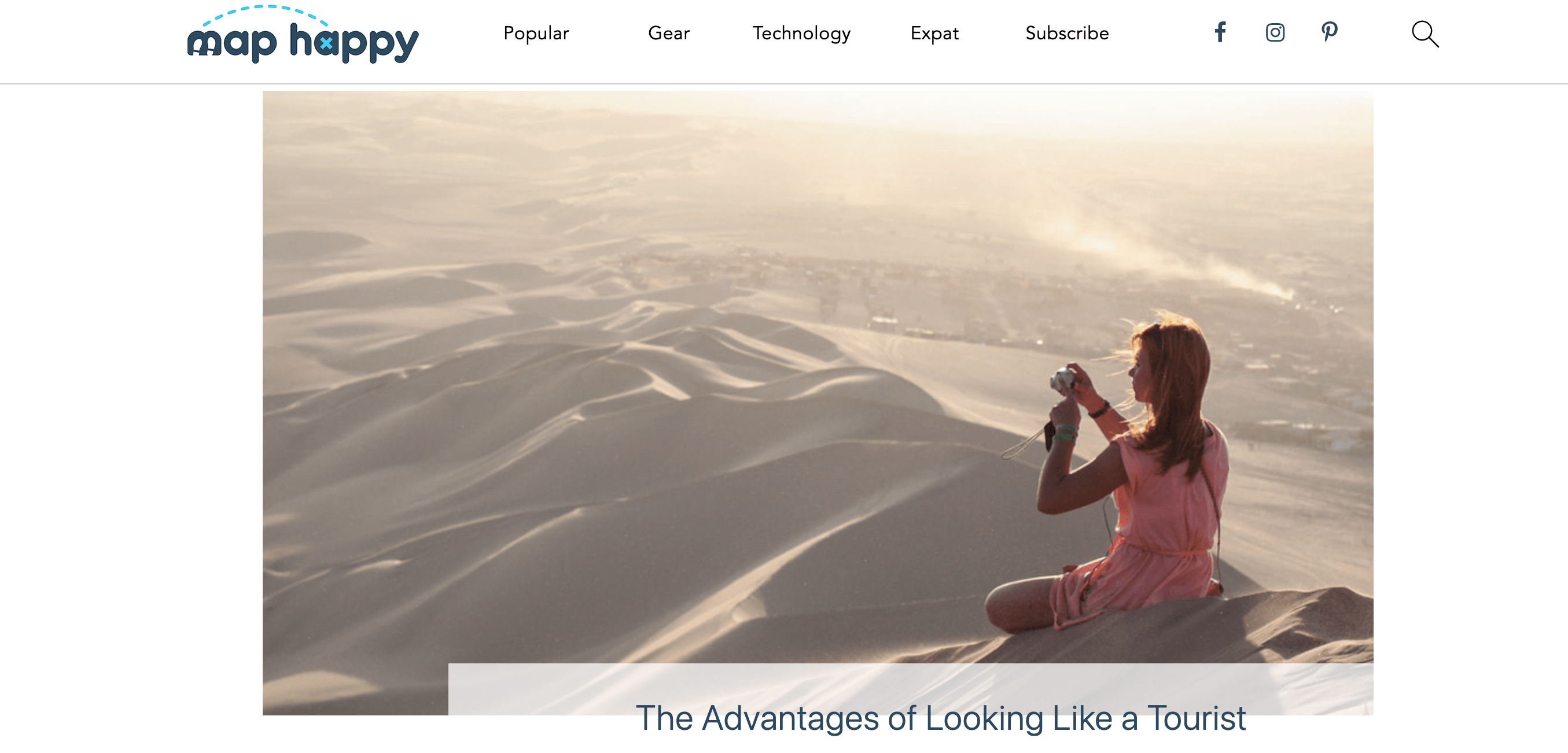
Map Happy is a travel journalism website focused on “practical traveling”, as its authors state. It is all about giving advice and tips on matters related to travel: from getting a visa to overcoming the language barrier issue.
The platform was created by the joint effort of a whole team of authors, editors and travel experts. The content is versatile and includes travel guides, news, somewhat similar to phrasebooks, instructions, and more.
In contrast to many other travel platforms, Map Happy is “technically-oriented”, looking into the details of traveling rather than sharing the author’s impressions and memories. Posts are added regularly, one or two times per week.
In 2016, Map Happy won a prize for the Best travel journalism site, awarded by the Society of American travel writers.
Key Numbers
| Domain rating | Backlinks | Keywords | Traffic |
| 47 | 6.2К | 44.3K | 17.9K |
Followers on Social Media
| 3.5K | 3.9K | 1.8K | 13K viewers/month |
Traffic Sources
The most important traffic source is organic search results, direct traffic accounts for about 11% of the visitors, while a small portion of them come also from referrals, social networks or paid search results.
| Direct | Referrals | Social | Organic search | Paid search |
| 11.40% | 0.36% | 0.23% | 87.80% | 0.12% |
Monetization Strategy
Map Happy is monetized via affiliate links and ads. Affiliate links are placed inside blog posts. It publishes sponsor posts and reviews, audience poll, display ads through prime spots and sticky bars on the website, and more.
Also, advertisers can reach out to the Map Happy audience via their social media channels.
Key Takeaways and Why We Consider It To Be a Great Example
- An award-winning travel blog featuring brilliant journalism collaborations
- A lot of useful, practical tips for all travel matters
- Consistent posting schedule
- High domain authority
- A loyal community (with direct traffic accounting for 11% of the blog’s visitors)
Alajode
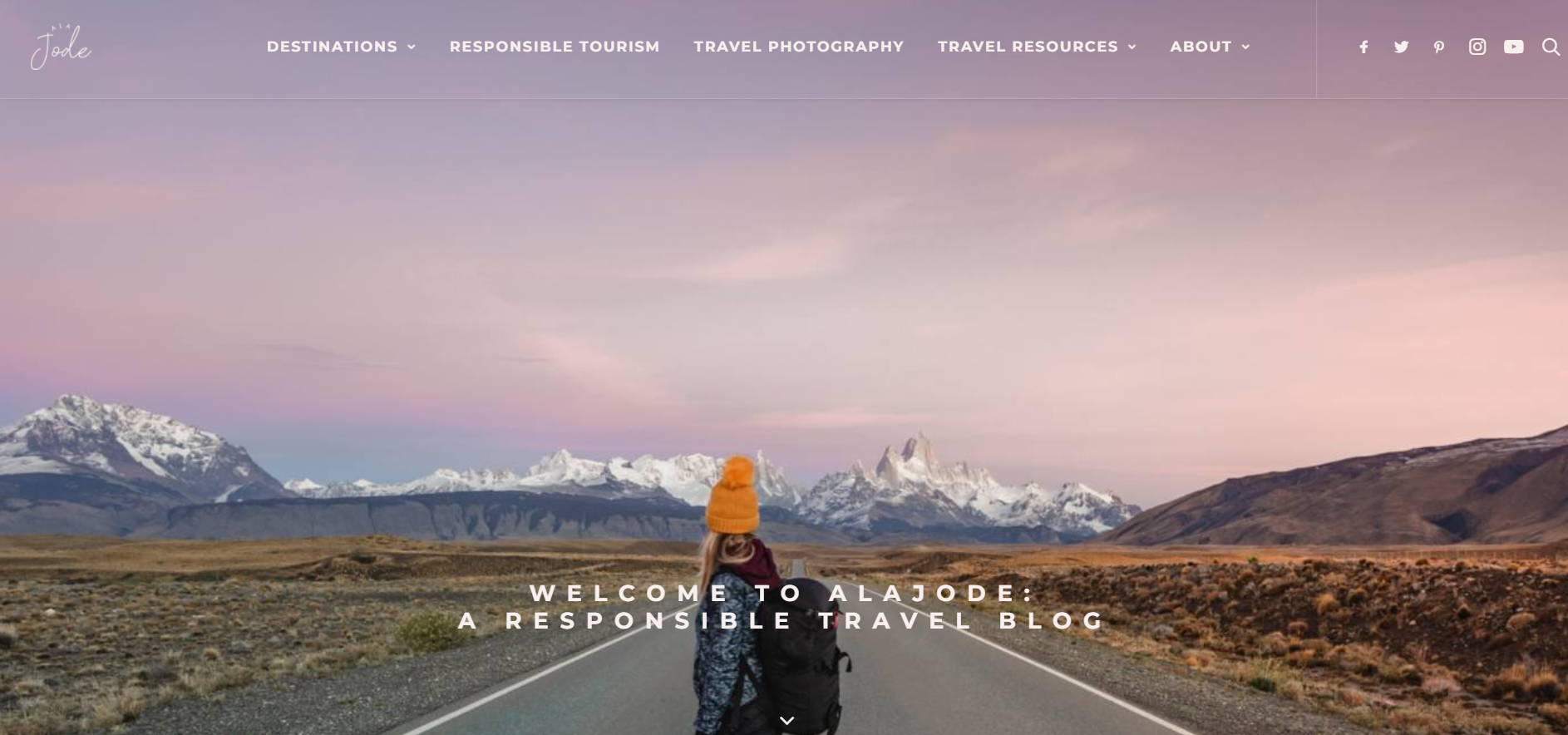
Alajode is a travel blog launched by a former linguist and now a digital marketer Jodie. Blogging is Jodie’s full-time occupation, and you can find various guides on this website: the most unusual bars, city breaks, and more.
Jodie is also passionate about health, style, minimalist living and self-development, so you can find tons of materials on these subjects as well, with a particular focus on the digital nomad lifestyle: there are guides, blogging tips and even a digital nomad network that you can join. Every once in a while, Jodie publishes guest posts from other bloggers.
Apart from articles and top-notch photos, you can also take a look at Jodie’s YouTube channel where she shares a lot of “behind-the-scenes” videos.
Key Numbers
| Domain rating | Backlinks | Keywords | Traffic |
| 35 | 1.5K | 10.4K | ~46K |
Followers on Social Media
| YouTube | ||||
| 1.7K | 11.3K | 5.8K | 285.5K viewers/month | 25.8K |
Traffic Sources
This blog acquires visitors mostly through organic search and social networks, and the rest of the traffic is either direct or coming from referrals, as you can see in the table below:
| Direct | Referrals | Social | Organic search |
| 14.02% | 1.75% | 20.00% | 64.22% |
Monetization Strategy
The blog is monetized through affiliate links and ads placed within blog posts. Advertisements also appear in the pop-up window at the bottom of the screen and in the sidebar. Some of the affiliate links appear as a button, just like any other “Read the post” button on the website, so it’s hard to tell right away which one will direct you to an advertiser’s website.
In the picture below you can see “Read the post” and “Check your dates” buttons that look the same, but one of them directs to another blog post while another is affiliate:

Key Takeaways and Why We Consider It To Be a Great Example
- Strong social media presence, especially on Pinterest and YouTube
- A lot of destinations covered with various types of guides
- Niche blog with a focus on responsible tourism
- A strong community with over 14% direct traffic
- Elegant blog design
Travel&Destinations
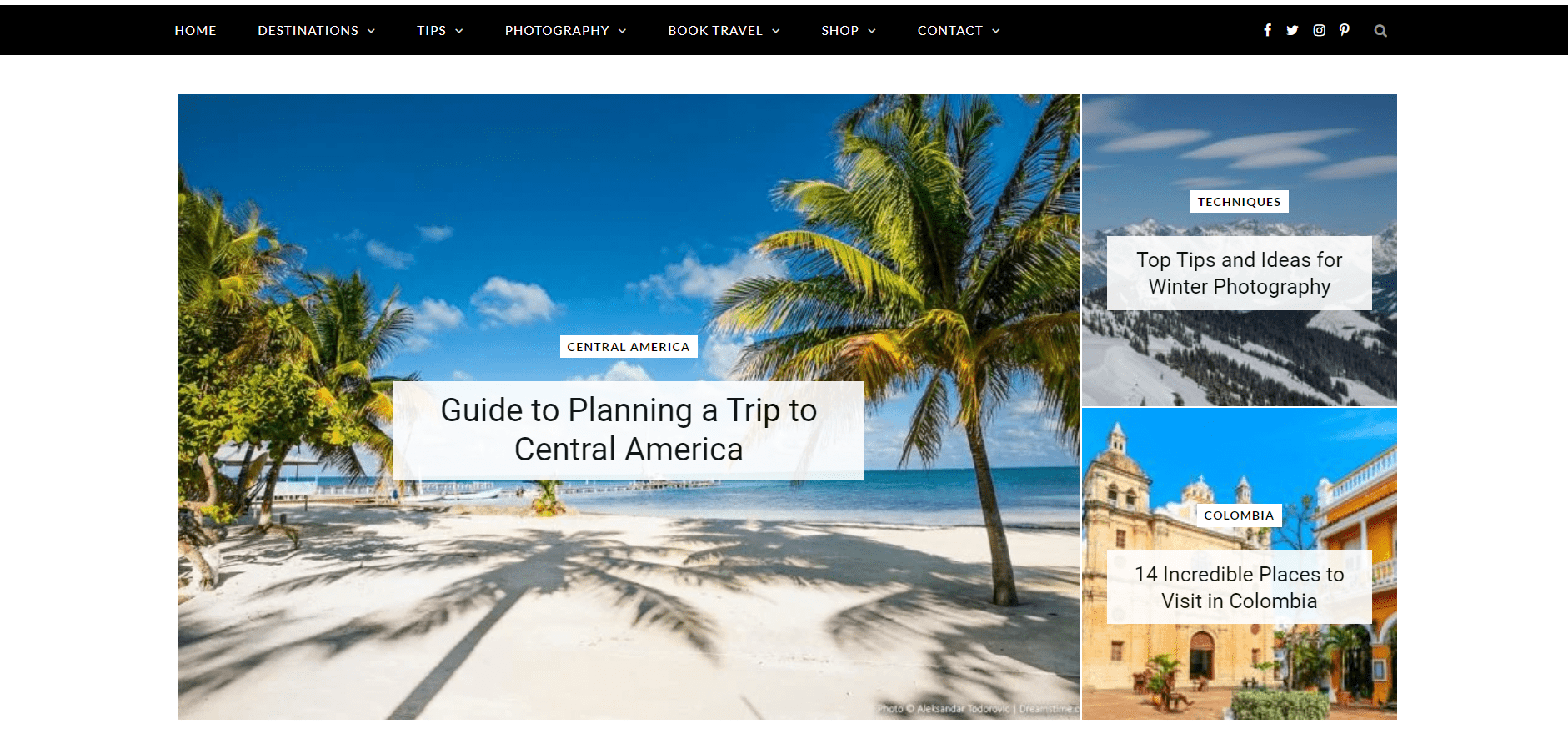
Travel & Destinations is a travel resource designed to inspire people to travel the world and provide helpful tips and advice. It was created by Mike Clegg, a great traveler and photographer.
Together with a team of authors, Mike writes about various destinations in Africa, Asia, Oceania, Europe, Middle East and North America and targets quite a wide audience by providing versatile guides that you can filter by destination or trip type (active, city break, etc.).
Apart from guides, you can find multiple tips on blogging, health and fitness, money, photography, social media promotion, as well as product reviews and interviews with travel photographers, writers, artists, flight attendants and pilots.
Travel&Destinations is among those good affiliate websites that feature works of various authors and are able to cover a topic from different sides.
Key Numbers
| Domain rating | Backlinks | Keywords | Traffic |
| 46 | 8.2K | 26K | 10.3K |
Followers on Social Media
| 6.7K | 618.3K | 2.5K | 156K viewers/month |
Traffic Sources
The great majority of visitors come from organic search results. Direct traffic is the second biggest channel, and the rest of the readers come from either referrals or social networks.
| Direct | Referrals | Social | Organic search |
| 9.10% | 1.36% | 2.21% | 87.34% |
Monetization Strategy
Travel&Destinations resort to advertising and affiliate marketing. There are context ads in the right-hand sidebar and inside blog posts. Affiliate links are placed within the posts as well, highlighted by a blue color just any other links on the website.
At the end of each travel guide, there are a few affiliate links and a promotional widget accompanied by a notification of its affiliate nature, as you can see in the example below:
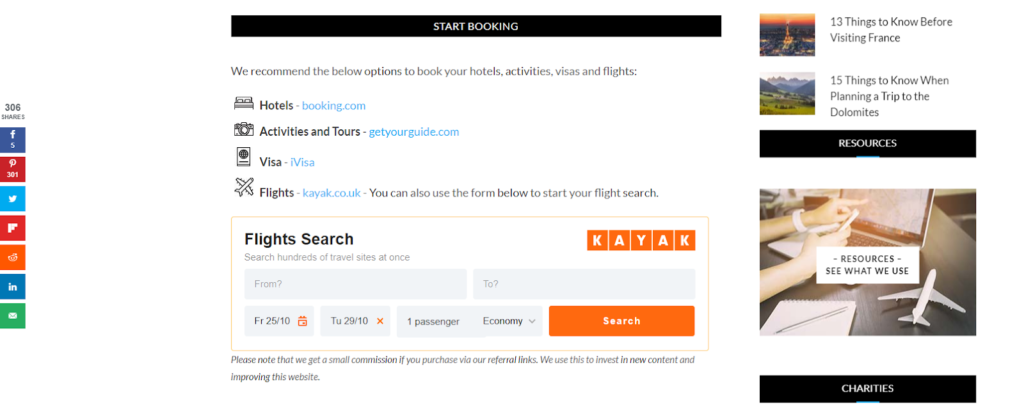
Furthermore, there are a few affiliate links placed at the bottom of the screen in such a smart way so that they don’t disturb you when you read but are still perfectly visible.

Key Takeaways and Why We Consider It To Be a Great Example
- Versatile content, from travel guides to photography tips to lifestyle advice to product reviews and more
- Many destinations worldwide are covered
- Simple and easy-to-navigate design
- Very high domain authority
- Strong social media presence, especially on Instagram
- Keyword-rich content
Here To Travel
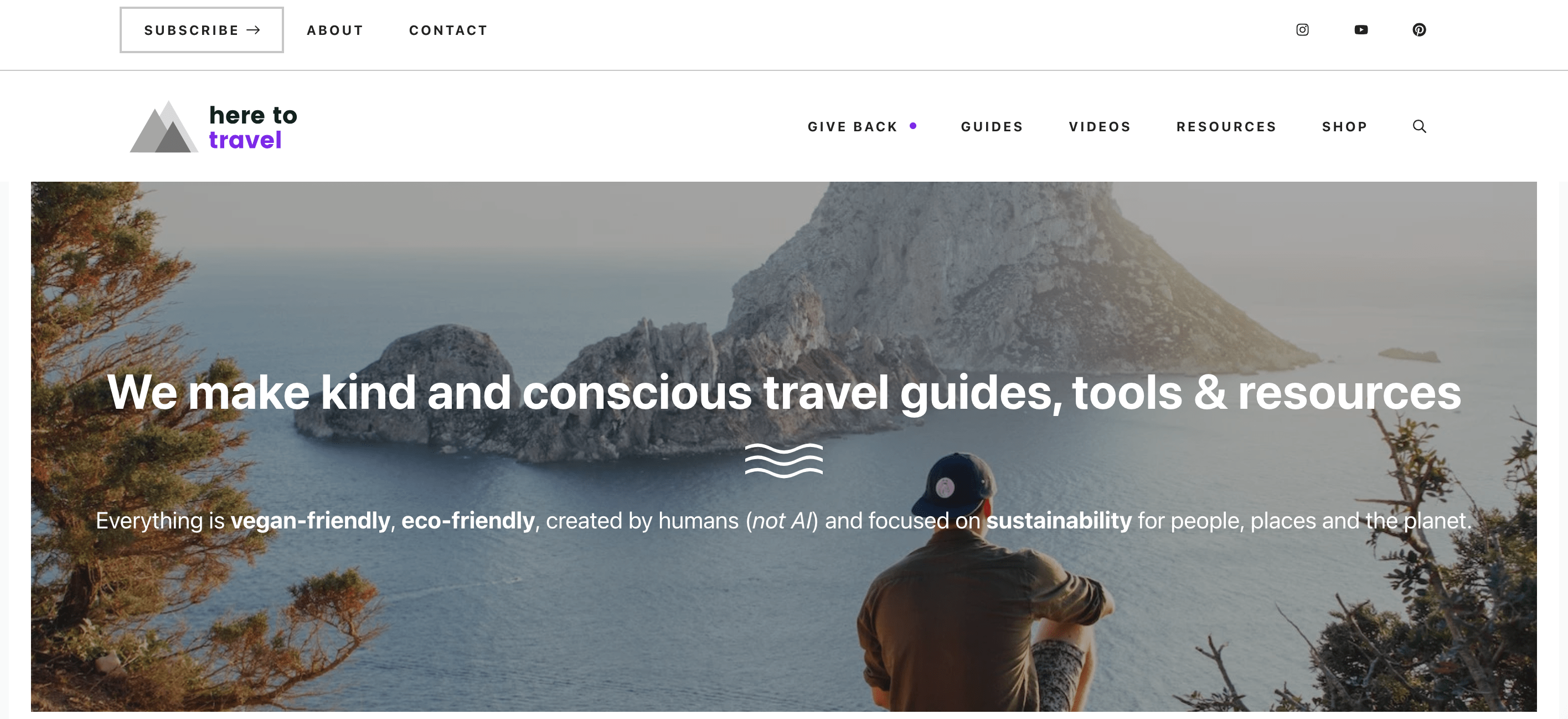
HereToTravel is another example among many successful affiliate websites. It provides travel guides to some of the world’s less explored places and gives advice on veggie & vegan food around the globe.
Matt and Jade, the blog authors, are a married couple passionate about exploring places that are not crowded and sharing their knowledge with the audience.
On this website, you can find not only articles but also podcasts and filter the posts by destination or category: food, inspiration, guides&tips, and see&do. The content is versatile and includes guides on city breaks, gift ideas, throwing a party, visiting famous sights for free, booking hotels and more. There is also a small YouTube channel.
Key Numbers
| Domain rating | Backlinks | Keywords | Traffic |
| 27 | 1.7K | 4.3K | 1.5K |
Followers on Social Media
| over 500 | 3K | over 600 | 55K viewers/month |
Traffic Sources
Almost all the website visitors come from organic search results, while a small proportion of traffic is direct.
| Direct | Organic search |
| 6.99% | 93.01% |
Monetization Strategy
HereToTravel makes money through commissions from affiliate links that users can find throughout articles and in the “Resources” section. Also, there are affiliate search form widgets placed inside the blog posts (up to three widgets within one article):
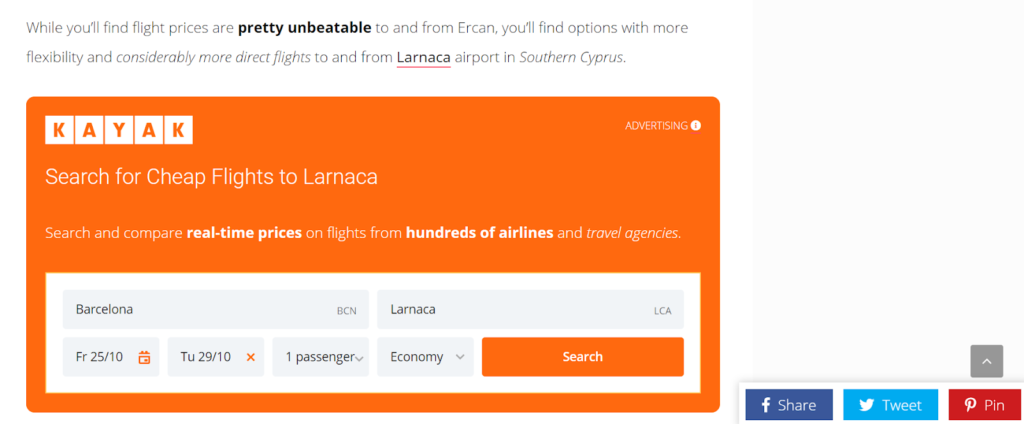
Key Takeaways and Why We Consider It To Be a Great Example
- Strong social media presence, especially on Pinterest
- Integration of various affiliate tools
- Niche website with a focus on eco-tourism and vegan cuisine
- Personal experiences shared in the content makes it easy to relate to
FlunkingMonkey
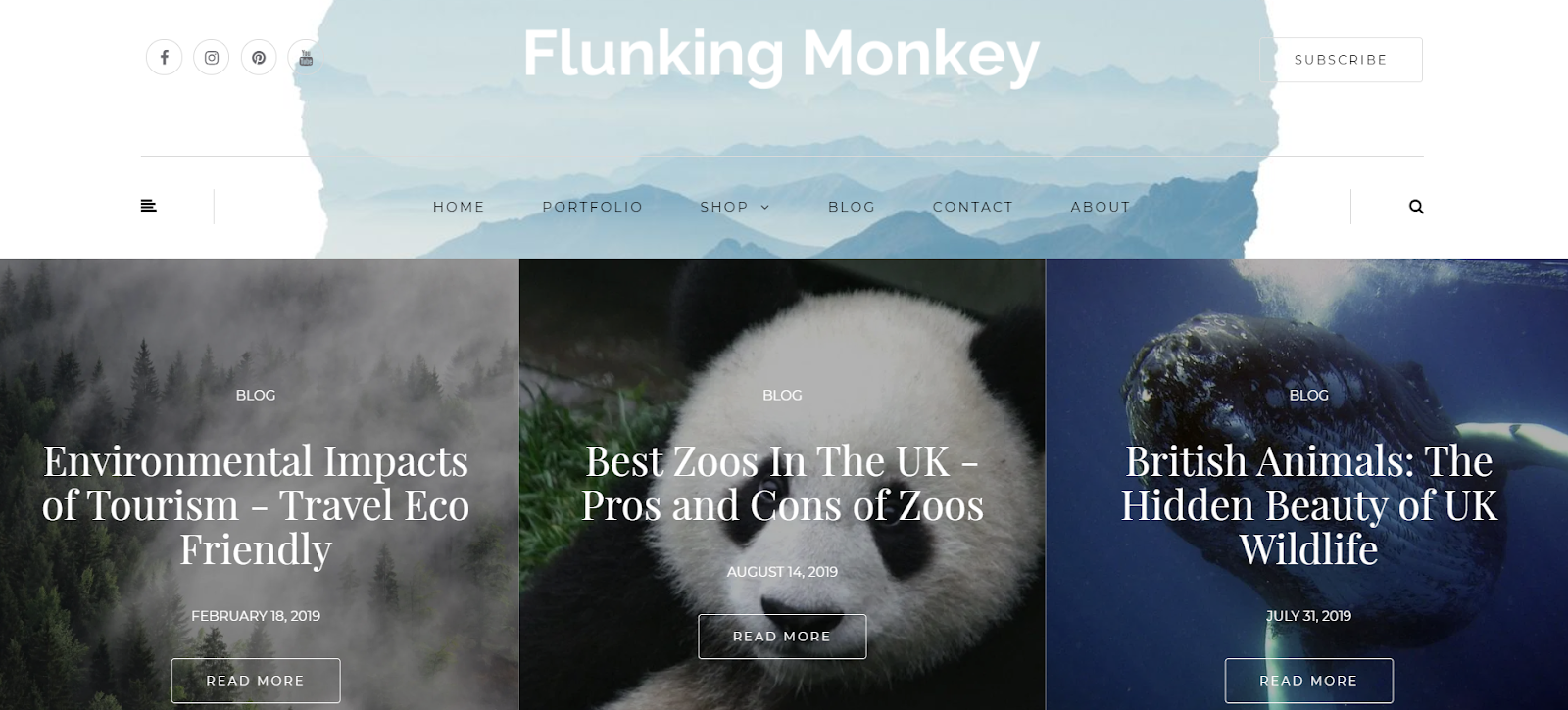
FlunkingMonkey is a personal blog of a travel photographer Neel Wanders. As Neel’s motto “Leave the world a better place” suggests, his website is ecology-focused: you’ll be able to learn about eco traveling, wildlife, road trips, experience hotels, sustainable brands, eco-friendly resorts and much more. Also, Neel offers an opportunity to donate money to conservation and biodiversity projects.
The platform presents various content types such as imaginary, videos and articles on travel and nature from the perspective of ecology. Neel also has a YouTube vlog, where he shares the travel experience around the world.
Key Numbers
| Domain rating | Backlinks | Keywords | Traffic |
| 3.7 | 148 | 1.2K | 189 |
Followers on Social Media
| YouTube | |||
| 6.4K | 132K | over 900 | 266 viewers/month |
Traffic Sources
Over half of readers stumble upon the blog in organic search results. Direct traffic accounts for over one-third of the visitors, while the rest of the traffic falls on social media.
| Direct | Social | Organic search |
| 36.52% | 3.07% | 60.41% |
Monetization Strategy
The website is funded through affiliate links and ads. Context advertisement is used on the homepage and in the right-hand sidebar. Widgets are also placed in the sidebar, as in the example below:
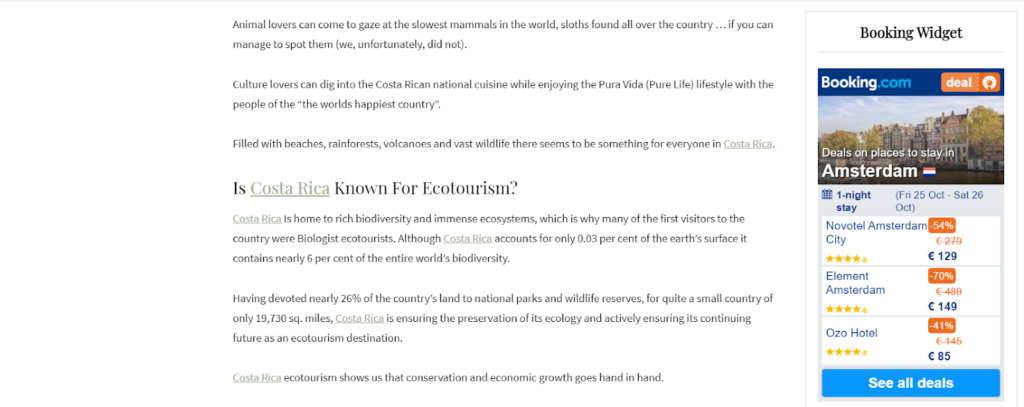
Key Takeaways and Why We Consider It To Be a Great Example
- Narrow focus on sustainable travel and environmental protection
- Beautiful blog design
- High-quality photography
- Large community on Instagram with an impressive share of direct traffic
The Travels of Bbqboy and Spanky
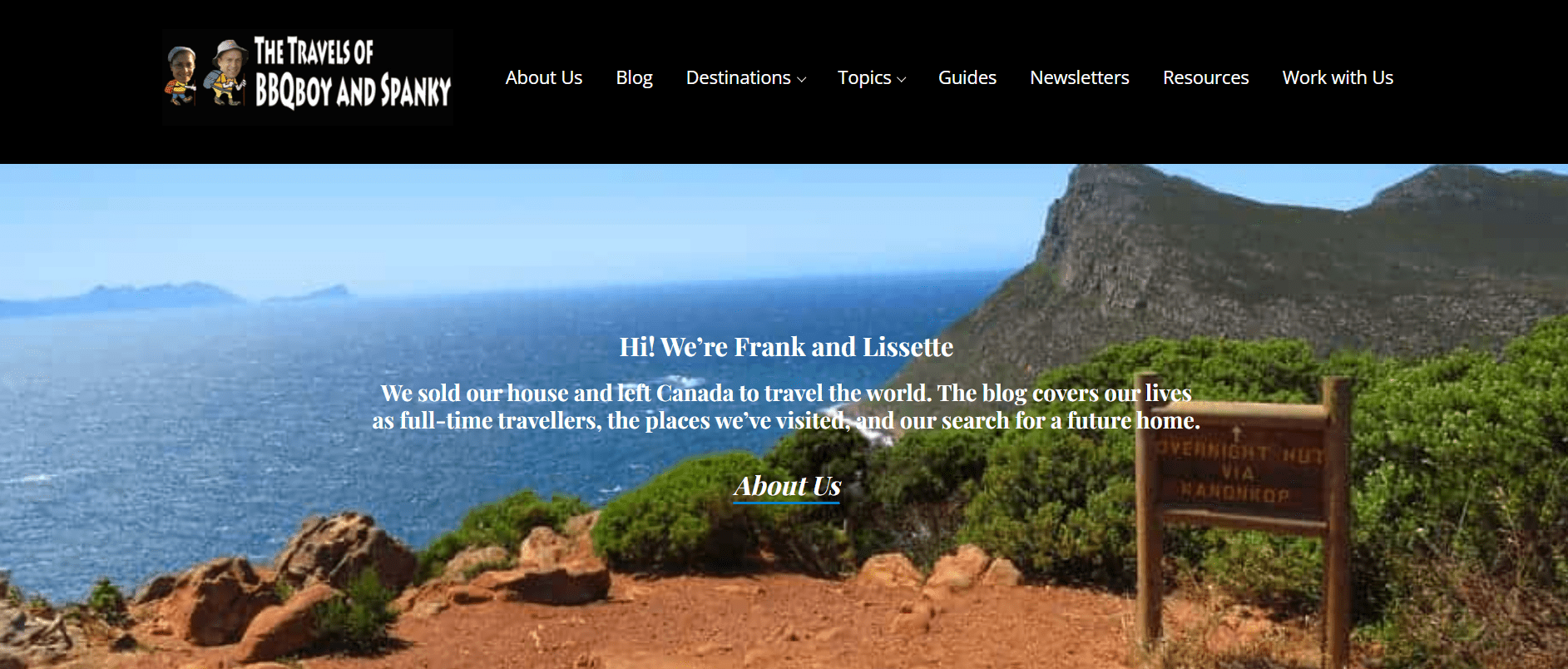
Frank and Lisette from Canada run this blog in order to share their experience of selling a house and traveling the world ever since. The couple has been to over 45 different countries in search of adventures and a place to settle in the future and blog to document their trips and memories.
Frank and Liette focus on “slow” traveling and stay one to two months in each location which gives them an opportunity to carefully study the place and gather valuable insights.
On this website, you can find travel guides to various destinations in different parts of the world. Mostly, these are lists of places to visit and things to do for each location based on Frank and Lisette’s personal experience, illustrated with multiple photos and links to hotels, tours and transportation options.
Key Numbers
| Domain rating | Backlinks | Keywords | Traffic |
| 34 | 6K | 15.7K | 5.3K |
Followers on Social Media
| 18.4k | 2.5K | 6k | 206k viewers/month |
Traffic Sources
One of the biggest traffic sources of the BBQboy is organic search results, while the rest of the visitors come from direct search, referrals, social media, and display ads.
| Direct | Referrals | Social | Organic search | Display ads |
| 9.36% | 1.08% | 2.90% | 86.38% | 0.28% |
Monetization Strategy
The website is monetized through affiliate links, direct partnerships and context ads. The ads are placed in the sidebar and within blog posts, and there is a rather annoying pop-up ad at the bottom of the screen. Affiliate links, highlighted in blue like other links, are located inside blog posts and so are affiliate widgets.
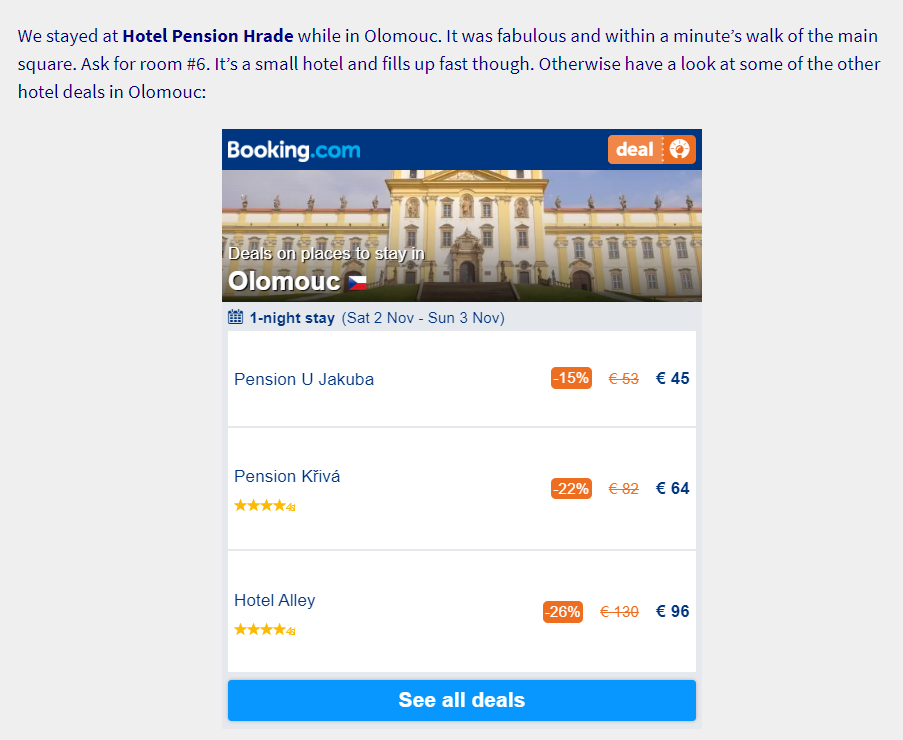
Key Takeaways and Why We Consider It To Be a Great Example
- Narrow niche blog with a focus on slow travel
- A lot of photography and personal experience shared
- Strong social media presence, especially on Pinterest
- High domain rating
- Keyword-rich content and a lot of backlinks
P.S. I’m on my way
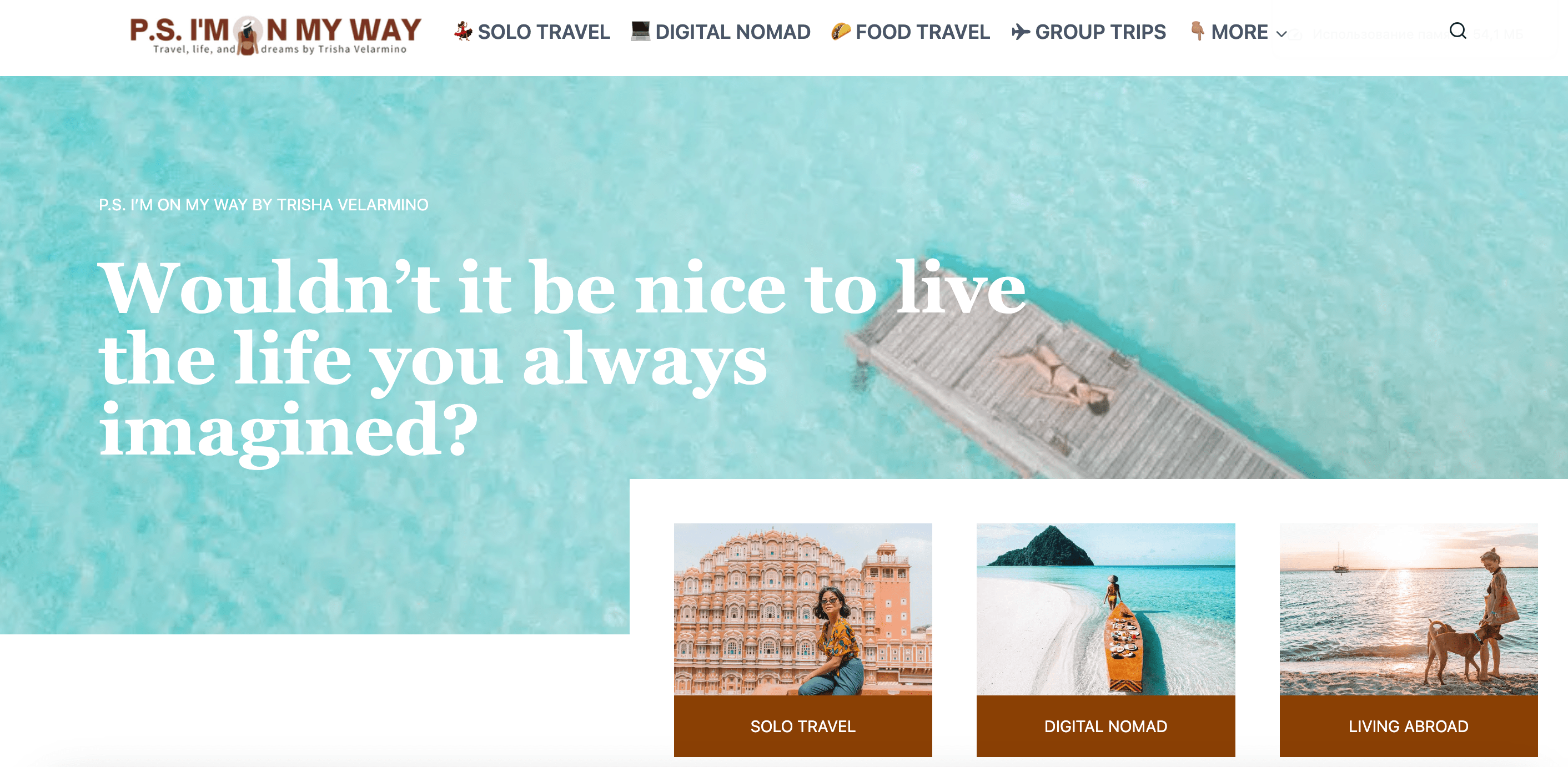
P.S. I’m on my way is an interesting example of travel affiliate websites. Trisha Velarmino, the website author, shares her experience of traveling the world or, as she says, “choosing to be somewhere else, all the time.”
On the blog, you can find comprehensive guides to 35 countries, including basic information about each destination, main landmarks, cost estimates for accommodation, food, transportation and daily budget, accommodation recommendations, gastronomic advice and related articles.
But short of that, P.S. I’m on my way is more than just a travel guide, as Trisha Velarmino tells so many stories from her life and shares beliefs and her opinion on money, politics, dating and a variety of other topics.
Key Numbers
| Domain rating | Backlinks | Keywords | Traffic |
| 49 | 12K | 7.2K | 2K |
Followers on Social Media
| YouTube | |||
| 28K | 65.6K | 5.5k | 13K |
Traffic Sources
The lion’s share of traffic falls on visitors coming from organic search results. The second biggest channel is direct traffic, and a small percentage of visitors come from social media and referrals.
| Direct | Referrals | Social | Organic search |
| 12.23% | 1.03% | 2.84% | 83.90% |
Monetization Strategy
The blog makes most of its money by sharing affiliate links and banners. Banners are placed in the sidebar, as you can see in the example below. And there is a context ad in the sidebar as well.

Key Takeaways and Why We Consider It To Be a Great Example
- Comprehensive travel advice for over 35 destinations
- A lot of personal experience and perspective shared
- High domain authority
- Strong social media presence
- Impressive share of direct traffic
Tomas Havel Photography
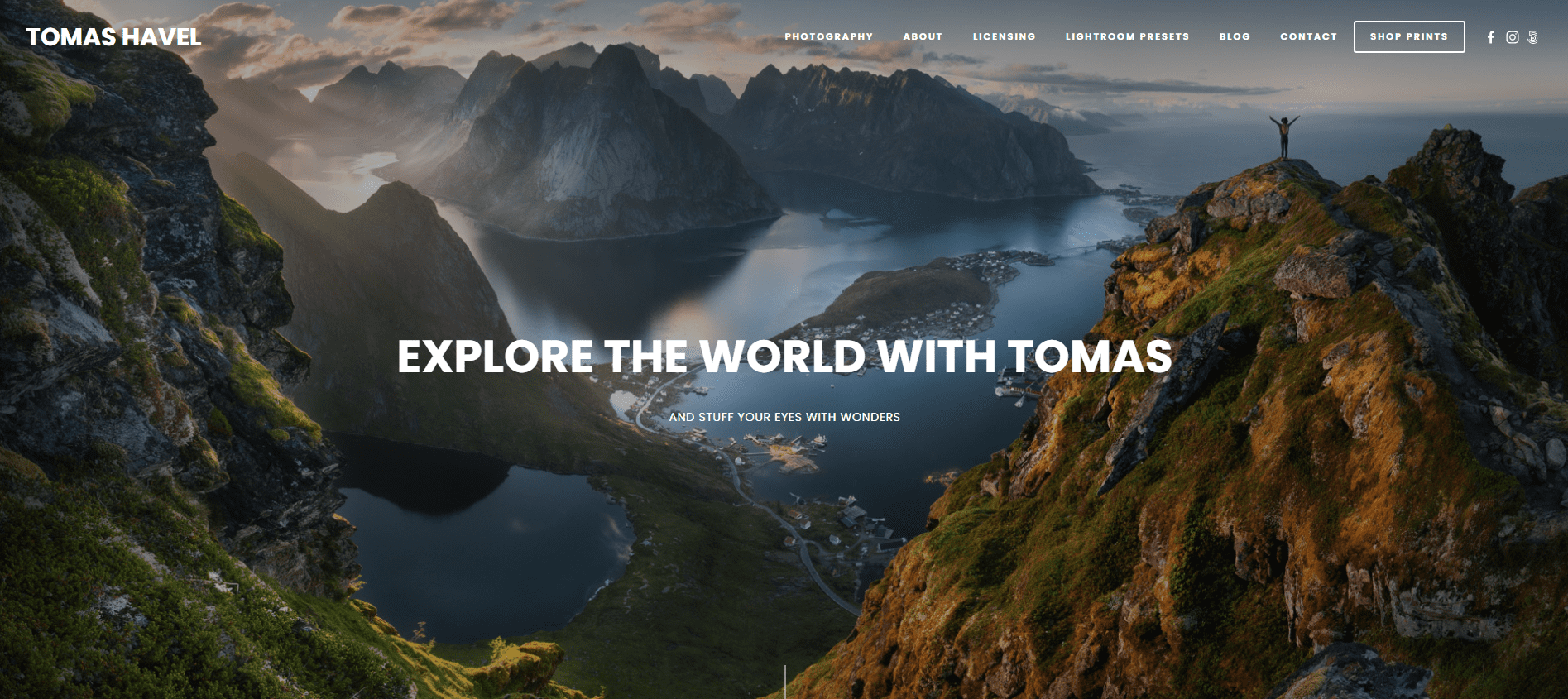
This is a personal website of Tomas Havel, a professional photographer from the Czech Republic. He focuses on travel and landscape photography and conveys an idea of how beautiful nature is through his works. Tomas also specializes in commercial, lifestyle and astrophotography. Some of the photos are accompanied by travel stories, but they are quite short and express Tomas’s memories of trips rather than provide comprehensive travel advice.
This resource is aimed at sharing the author’s works and promoting him as a professional, and it features just a few affiliate links, in contrast to other affiliate blogs, so it is not a typical affiliate website example to follow.
Key Numbers
| Domain rating | Backlinks | Keywords | Traffic |
| 17 | 384 | 189 | 79 |
Followers on Social Media
| 500PX | ||
| 32.8K | 168K | 4.6K |
Traffic Sources
Almost half of the traffic comes from social media, one-third of visitors are referred through organic search results and the rest of traffic is direct.
| Direct | Social | Organic search |
| 16.90% | 49.76% | 33.34% |
Monetization Strategy
It includes affiliate marketing, partnerships and product sales (photo prints). Tomas uses affiliate buttons at the end of blog posts that unobtrusively call readers to proceed to the partner’s website, as you can see in the picture below. Apart from affiliate marketing, Tomas monetizes the blog by selling photo prints.

Key Takeaways and Why We Consider It To Be a Great Example
- This blog combines the advantages of a personal portfolio and a source of useful tips
- Top-notch, award-winning photography
- Impressive social media community, with almost 50% social traffic share
- Diverse monetization strategies
Tara’s Travels
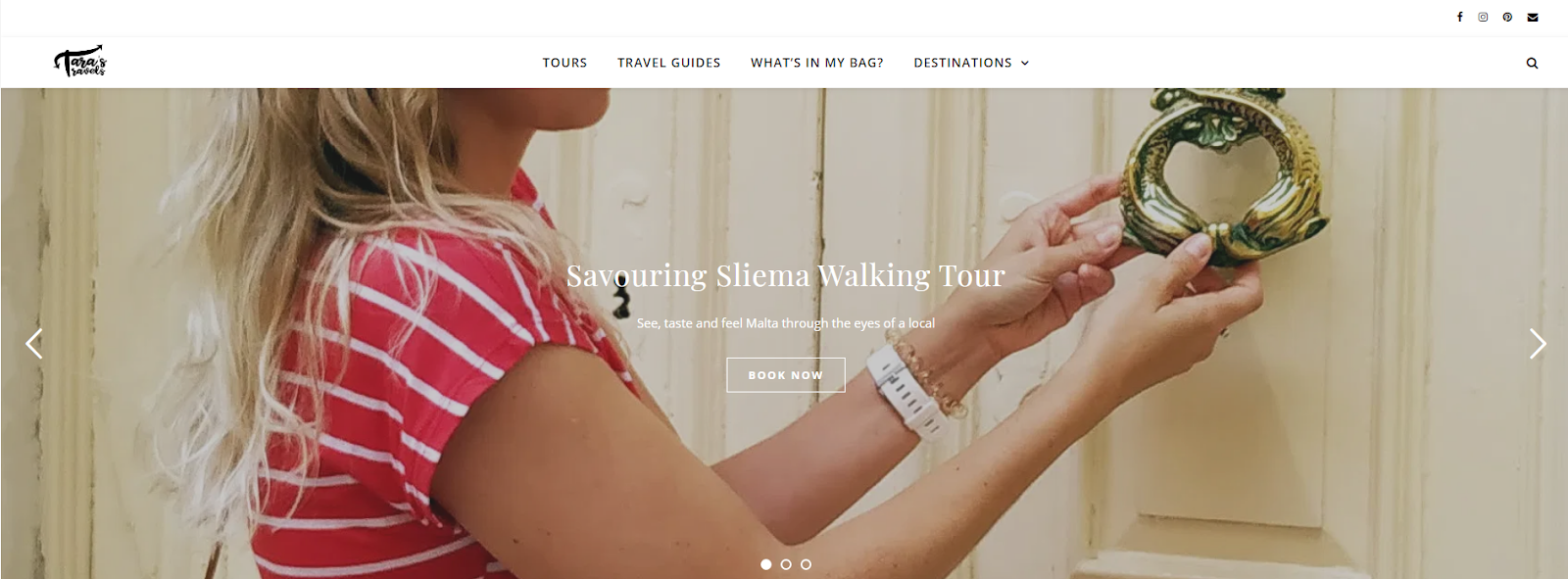
Tara’s Travels is a personal blog containing travel guides to various destinations in Asia, Europe and North America. Apart from must-see lists for Cambodia, Malta, Sicily and Switzerland, Tara shares her insights on different aspects such as climate differences, job placements difficulties, her favorite places to eat, drink, hike, and even videos. Not all the materials are recent, some of them date back to 2013 or so, and Tara publishes only a handful of posts throughout the year.
Key Numbers
| Domain rating | Backlinks | Keywords | Traffic |
| 6 | 106 | 31 | 6 |
Followers on Social Media
| over 400 | 2K | 5.8K viewers/month |
Traffic Sources
Tara’s Travels acquires all of its traffic through organic search results only.
Monetization Strategy
As for monetization strategies, Tara offers private walking food tours in Sliema, Malta, that you can book on Airbnb or dozens of other activities such as hiking, market tours, cooking classes and more. The links to the activities you can find inside and at the end of blog posts.
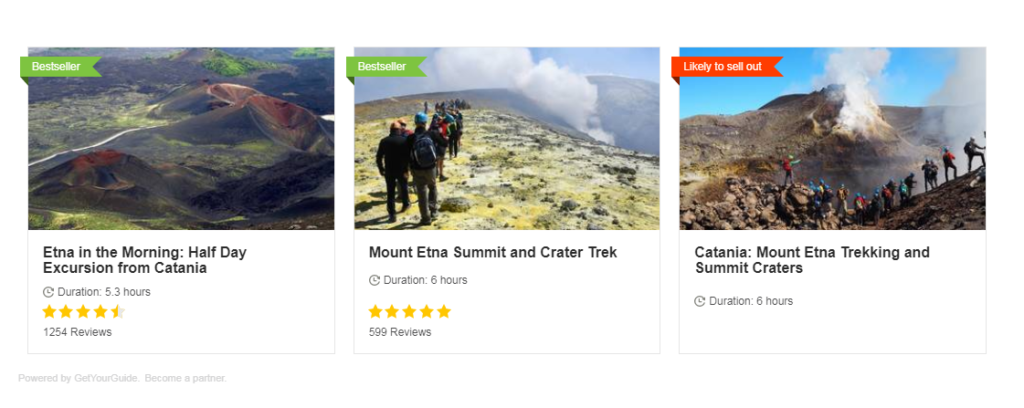
Key Takeaways and Why We Consider It To Be a Great Example
- Good-quality photography and easy-to-read content
- Comprehensive travel guides to destinations around the world
- Good social media presence on Pinterest
The Nerdy Me
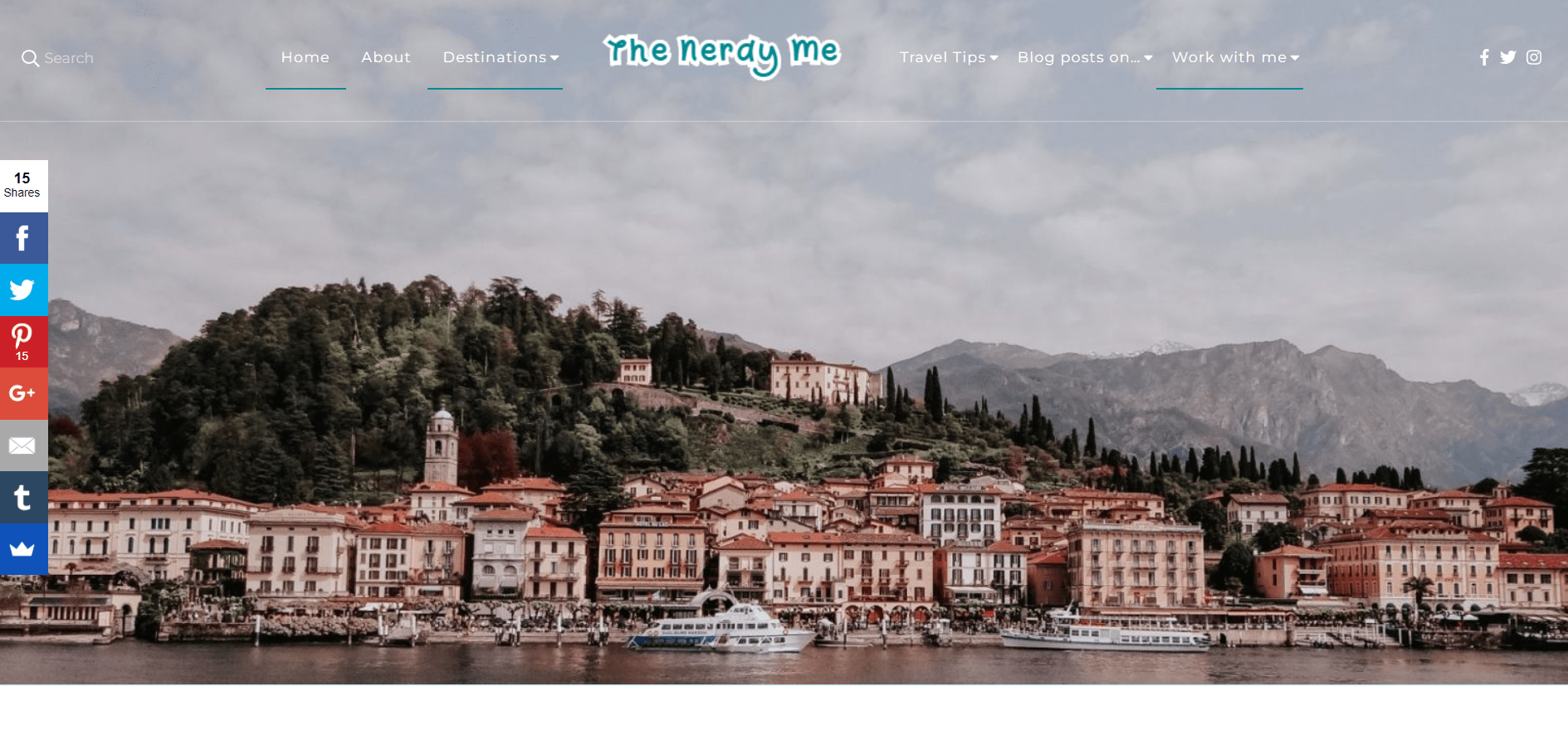
The Nerdy Me is a beautifully designed affiliate website example providing travel insights, blogging tips, motivational pieces and fun lists.
The content is quite versatile and is split into many categories such as lifestyle, blogging, wellness, travel, food and more. You can also filter it by series such as motivational posts, weekly finds and lists.
As for travel guides, Leta, the blogger behind The Nerdy Me, prepares comprehensive guides and shares tips from personal experience as she has a long list of visited countries and cities.
Key Numbers
| Domain rating | Backlinks | Keywords | Traffic |
| 24 | 576K | 1.6K | 219 |
Followers on Social Media
| over 200 | 1.6K | 1.8K | 51.7K viewers/month |
Traffic Sources
More than half of the visitors are directed to the website through organic search results. The second biggest channel is direct traffic, and the remaining percent falls on social traffic.
| Direct | Social | Organic search |
| 34.99% | 1.77% | 63.24% |
Monetization Strategy
Leta uses affiliate links and widgets in blog posts (example below) and on the “Travel resources” page.
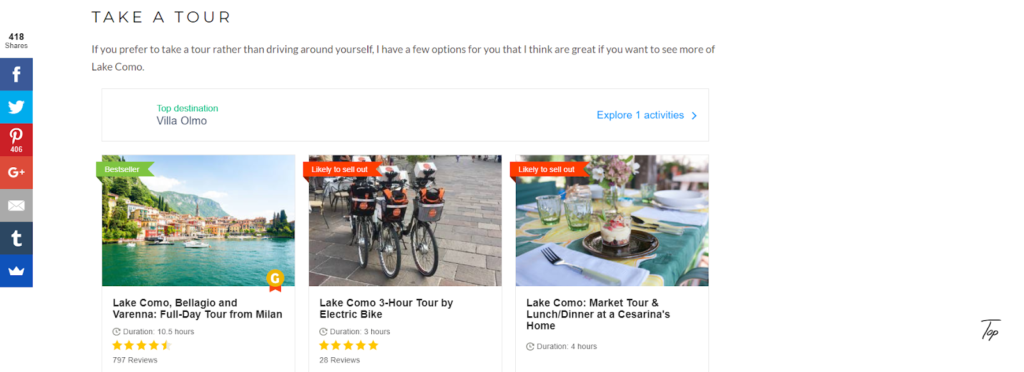
Key Takeaways and Why We Consider It To Be a Great Example
- Stunning blog design
- Versatile content with many different content categories
- Strong share of direct traffic
- Strong presence on Pinterest
TravelTables
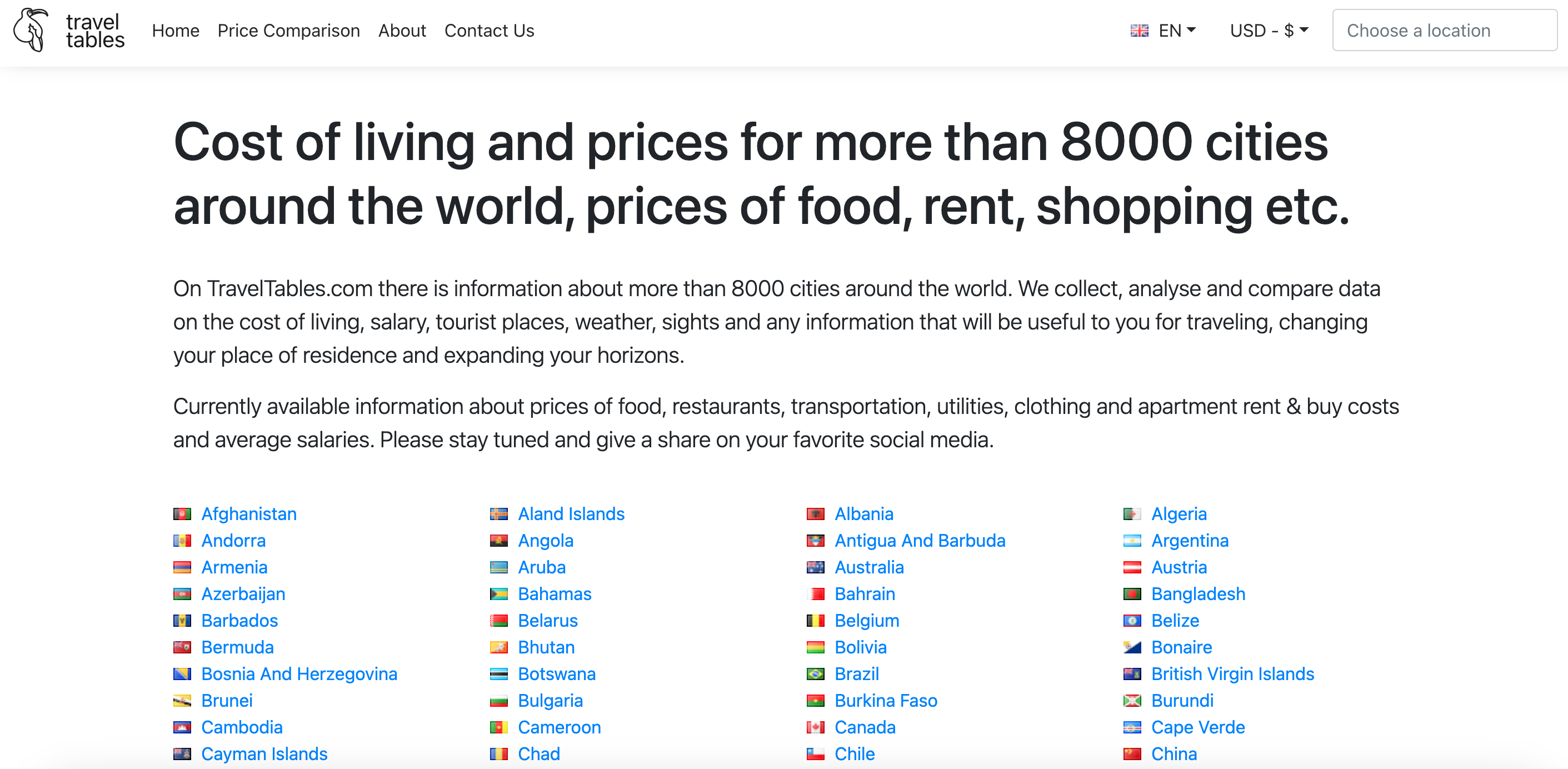
This is another good example of top affiliate marketers. On Travel Tables, you can compare prices for accommodation, sightseeing, transportation, clothing, food, salaries and many more parameters to choose the best destination for yourself.
The database includes over 8,000 cities worldwide and is constantly updated. Users can type in two destinations that they want to compare and receive the information. It’s possible to update the prices and help other readers get the best available data.
Also, you can find travel guides, for example, for the United Arab Emirates, and the world average cost of living & price map, providing a visual overview of the global situation.
Key Numbers
| Domain rating | Backlinks | Keywords | Traffic |
| 28 | 1.5K | 12.2K | 3.8K |
Traffic Sources
The lion’s share of traffic comes from organic search, while the rest of visitors are directed through email marketing, referrals, social media or arrive directly on the website.
| Direct | Referrals | Social | Organic search | |
| 9.43% | 0.25% | 3.02% | 5.21% | 82.10% |
Monetization Strategy
The website is funded through affiliate marketing and context advertising. Ads are located on the homepage as well as on every page with price comparison. Affiliate widgets are also located on price comparison pages, and their content depends on what locations you compare:

Key Takeaways and Why We Consider It To Be a Great Example
- Niche blog aiming to help readers compare different destinations in terms of costs, weather, transportation, and more
- Keyword-rich content and a strong backlink profile
- Good direct traffic share
The Lilac Scrapbook
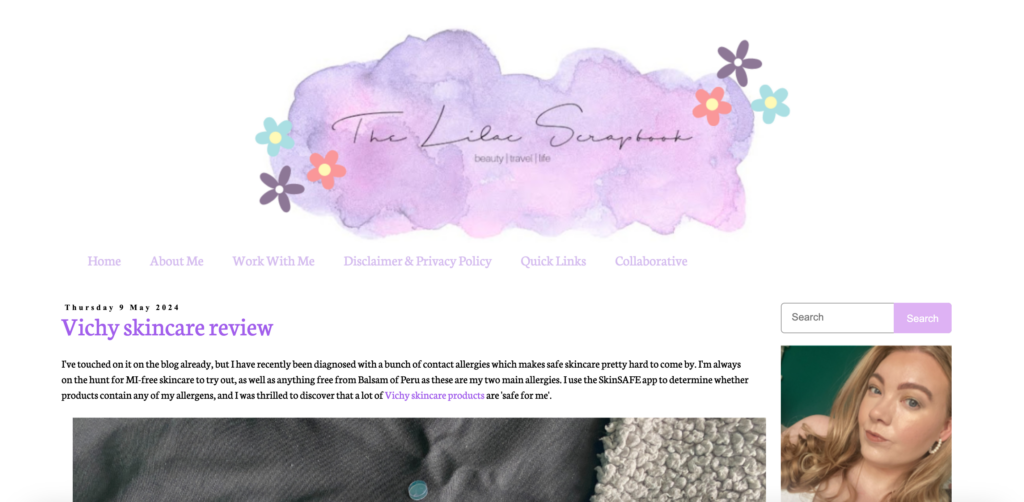
This is another success story for bloggers who write travel tips, product reviews and simply share snippets from their lives.
The blog has a pretty simple layout: all the posts are published on one page. Katy also talks about her trips in Europe and other places, shares memories from traveling and provides detailed information on what transport to take and where to go while on vacation. There are many relevant links to places such as museums and restaurants as well as products that Katy recommends: clothing, makeup and more.
Key Numbers
| Domain rating | Backlinks | Keywords | Traffic |
| 9 | 177 | 311 | 41 |
Followers on Social Media
| less than 500 fans | 2.6K | 9.7K |
Traffic Sources
Most traffic comes to the blog from organic search, while direct channel accounts for the rest of visitors.
| Direct | Organic search |
| 39.67% | 60.33% |
Monetization Strategy
The blog is monetized through affiliate links and sponsored content. Promoted products are accompanied by an asterisk in blog posts. There are affiliate banners in the sidebar and in the footer.
Key Takeaways and Why We Consider It To Be a Great Example
- Simple, yet beautiful layout
- A lot of personal experiences and photos shared
- Many useful travel recommendations
- A loyal community with about 40% direct traffic share
The Atlas Edit
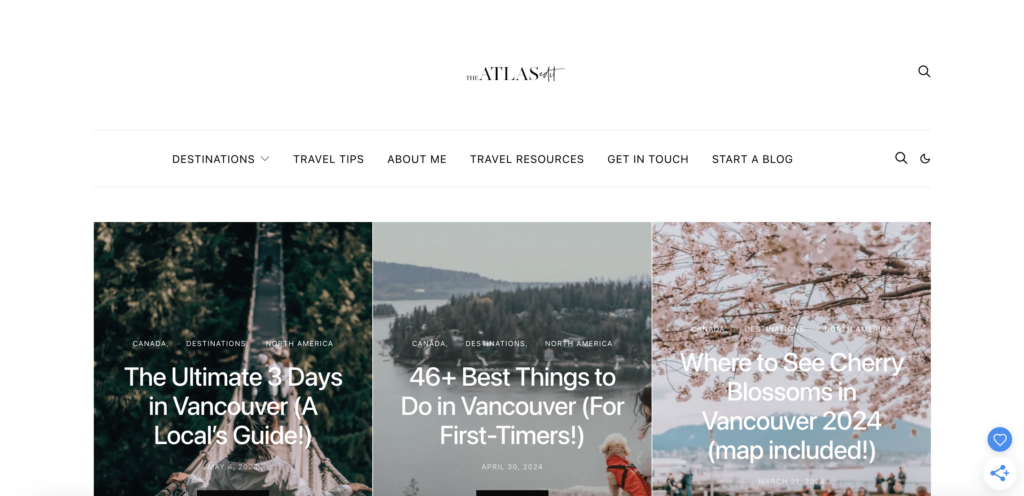
Stephanie, the blogger behind The Atlas Edit, shares her traveling experience to over 40 countries worldwide. On this blog, you can find comprehensive guides including sights to see and places to eat at. You can filter guides by destination.
On the page “My recommendations” you can find links to various services that Stephanie recommends to use for booking flights and accommodation, getting around, choosing tours and activities and more. There is also an 8-step guide to planning your trip and a printable planner. Apart from traveling tips, Stephanie shares her blogging experience and talks about website monetization.
Key Numbers
| Domain rating | Backlinks | Keywords | Traffic |
| 9 | 202 | 2K | 272 |
Followers on Social Media
| over 600 people | 3K | over 180 | 176.9K viewers/month |
Traffic Sources
This website receives traffic mostly from direct and organic searches, while social media bring about one-fifth of traffic.
| Direct | Social | Organic search |
| 41.47% | 18.84% | 38.69% |
Monetization Strategy
The blog is monetized through a commission from affiliate links and ads. There are two links in the “Booking discounts” section in the sidebar and context ads inside blog posts.

Key Takeaways and Why We Consider It To Be a Great Example
- Comprehensive travel guides for worldwide destinations
- Beautiful and easy-to-navigate blog design
- Keyword-rich content
- Strong presence on Pinterest
- Impressive shares of both direct and social media traffic
What You Can Learn From These Affiliate Marketing Websites
As the affiliate marketing website examples above demonstrate, there are many blogging aspects to pay attention to if you want to grow a strong project and stand out from your competition.
One of the most important things that unites the examples above is their narrow focus. Blogging about everything is not a good idea if you want to gather an audience. Instead, choose a topic and grow your expertise in that field so you can bring real value and attract readers.
Another common feature is a strong social media presence. Even though social is not the biggest traffic source, it still accounts for a good percentage of visits and helps target a larger audience.
As you might have noticed, all the above website examples feature engaging content with photos and keywords. Content is king when it comes to drawing in readers and making them return again and again.
How You Can Start Your Own Affiliate Marketing Website
Luckily, to start your own affiliate marketing website, you don’t need years of writing and photography expertise. Passion and readiness to invest your time and grow your skills is good enough to begin your blogging journey. To learn about the skill set that every blogger should grow to become a success, join Travelpayouts Academy and take our free courses today.


